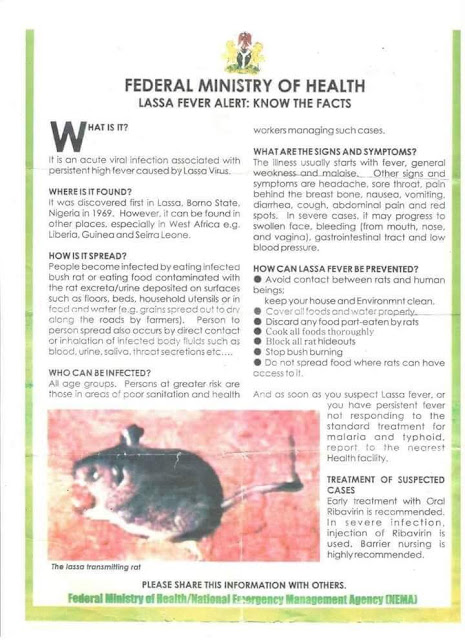10 Important Information About Lassa Fever-- 55A3D605
Lassa fever is one of the types of haemorrhagic fevers that affects human beings and could lead to sudden death. Other haemorrhagic fevers are Ebola Virus Disease (EVD), Dengue and Yellow fever.
Some of the symptoms of haemorrhagic fever are high fever, serious headache and bleeding from the pores of the body parts which are all characterised by high fatality.
1. Brief history of Lassa fever disease
Lassa fever is endemic in Nigeria. It was first discovered in a town called Lassa in Borno state in 1969. It was from the name of the town that the disease got its name.
2. Case
In disease terminology, a case is a person who has a disease and at the same time can spread the disease to people who do not have the disease. A case could either be suspected or confirmed. A suspected case for Lassa fever is characterised by gradual onset of fever, headache, malaise, myalgia, cough, pharyngitis, vomiting and retrosternal pain.
On the hand, a confirmed case is a suspected case that is laboratory-confirmed or epidemiologically linked to a laboratory-confirmed case or outbreak.
3. Index/Primary case
Index case is the person that first contacts a disease. He is also known as primary case.
4. Primary and secondary contacts
A Primary contact is a person that has direct association with a person that has a disease. An example of a primary contact is a Doctor treating a Lassa fever patient. While a secondary contact is a person that has direct contact with the primary contact.
5. Information from the Ministry of Health
According to a release by the Ministry of Health recently, in the last 6 weeks, Nigeria has been experiencing Lassa fever (LF) outbreak which has so far affected more than 8 states. The states affected include Bauchi, Nasarawa, Niger, Taraba, Kano, Rivers, Edo and Oyo.
The total number of suspected cases so far reported is 76 with 35 deaths, and a Case Fatality Rate (CFR) of 46%. The Ministry of Health laboratories have confirmed 14 cases, indicative of a new episode of Lassa fever outbreak.
Information on the Lassa fever outbreak as of Wednesday, January 13 confirmed that a person died as a result of the disease in the National Hospital at Abuja.
Previous report was that Lassa fever claimed 41 lives from 93 reported cases in 10 states of the country. The number of the suspected cases also rose from 86 last week to 93 this week. In addition a person died last week in Edo state.
6. Latest information
Twelve states have so far been affected. The states affected include Bauchi, Nasarawa, Niger, Taraba, Kano, Rivers, Edo, Plateau, Gombe, Abuja, Lagos and Oyo. Imo state has also recorded reported cases making the states to become thirteen.
Information learnt yesterday, Thursday, January 14 had it that a medical doctor died in Port Harcourt, the Rivers state capital as a result of Lassa fever.
7. Incubation period
The incubation period of a disease is the time it takes the disease to manifest and show its different symptoms if someone contacts it. For Lassa fever, the incubation period is 21 days. Therefore, if a person is suspected to have the disease, he will be put in an isolation room for 21 days in order to confirm if he/she has the disease or not.
8. Medical presentation and symptoms of Lassa fever
These include: High fever; serious headache; pains in the chest region; dry and sore throat; continuous stooling and vomiting; in severe situations, there is bleeding from the mouth, nose and vagina and then death results in later stages.
9. Preventing the disease/mode of transmission
Rodents and rats are the main vector of the disease. Someone can also be infected from the fluid or blood of an infected person and by shaking hands with people who are seriously infected.
10. Other preventive measures
People should ensure their food is properly covered, either cooked or uncooked. Liquid soap and antiseptics should be used to wash the hands. Also, other rules of regular hand-washing should be adhered to always. Rodenticides should be used to kill rats, while the bush around the home should be cleared regularly. The windows and doors of the house should be closed especially when it is night time.
Any body who shows the given symptoms above should report to the hospital immediately in order to prevent people not infected from coming up with the disease.
In addition, medical personnels should wear protective gloves and mask when treating people who are infected with the disease. All efforts should be geared towards maintaining a general personal, home and environmental cleanliness.
THINK IT IS IMPORTANT? SHARE WITH YOUR FRIENDS!
SOURCE: Naij.com



Comments
Post a Comment